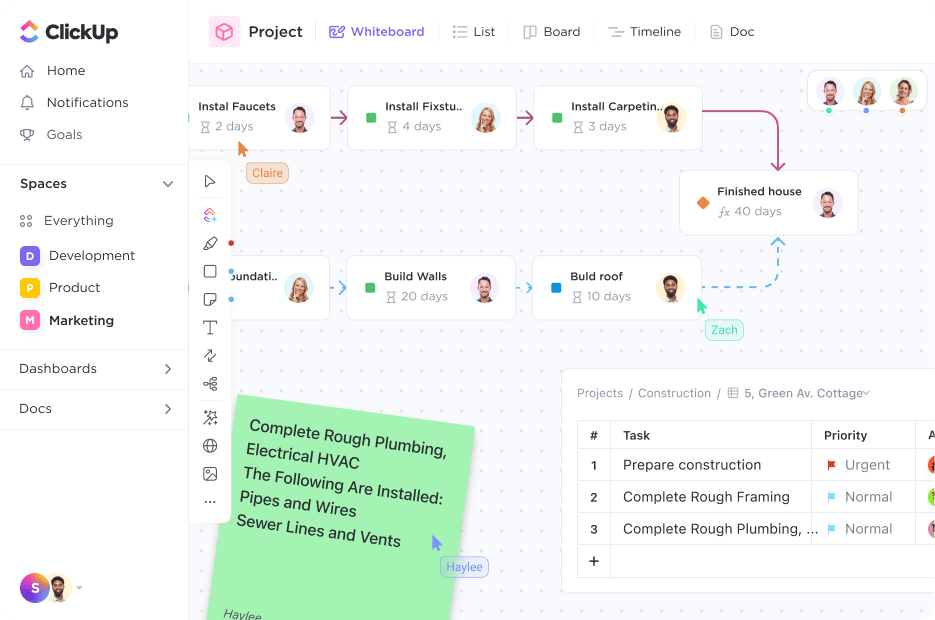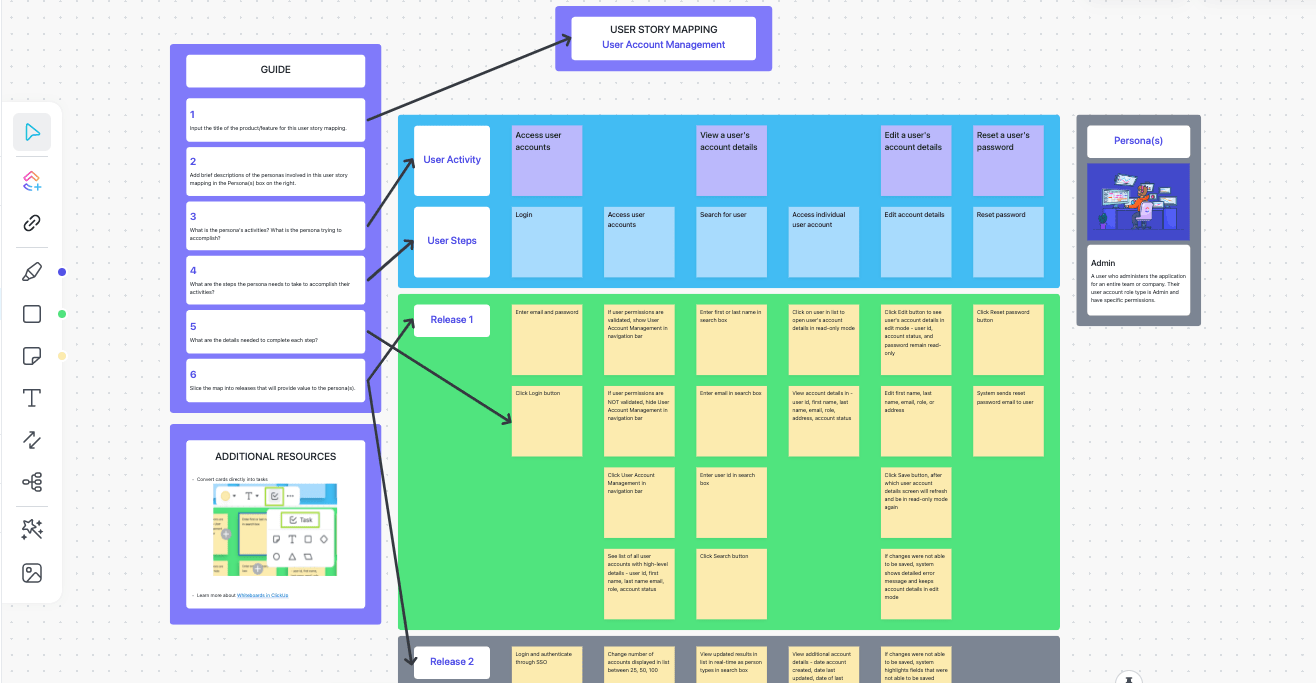

It’s Monday morning, and you’re in the middle of a brainstorming session to solve the problem that’s been plaguing your project for weeks. Then suddenly, you have an idea.💡🙌🏼
In the heat of the moment, you unmute your mic and start explaining the solution—with lots of hand gestures—until your team lead says, “Uhhh, that’s an idea.” 💀
Rather than letting your brain dump get the best of you, what if you were able to quickly sketch your vision?
Even better, what if you were able to present and collaborate on your mock-up with the team without skipping a beat? That’s the reality of introducing digital whiteboard software to your project management process. 🏆
In fact, when people hear the term “Whiteboard Project Management,” they’ll likely imagine a variation of this exact scenario. And while it’s totally valid (and super common), this example only scratches the surface of the infinite benefits this methodology has going for it!
It’s no secret that whiteboard project management is the next big thing and it’s not slowing down any time soon.
But if think you’ve got this project methodology covered because you finally hung that mini whiteboard in your kitchen—think again, my friend.
Let us take you through everything you need to know about whiteboard project management including what it is, how it can align with your workflow, and the templates you need to make the most of its benefits.
What is Whiteboard Project Management?
Digital whiteboards embrace the collaborative, creative, and efficient approach to project management that you’ve likely been missing! Plus, you don’t even have to be a project manager to benefit from digital whiteboard software. They are that versatile!

Representing and managing almost any project visually is one of the biggest advantages of whiteboard project management because it helps you find connections you may not have recognized before. It’s also more engaging and accessible for people who approach their work in different ways.
The collaborative nature of whiteboard software is also a huge benefit for agile teams who do the bulk of their work asynchronously, as it automatically stays up to date with the latest information. In this instance, you can think of your whiteboard as your own living document!

But whether your team is working in sprints or gearing up to plan the next company conference, whiteboard project management is there to support you. Ahead of your next initiative, have a whiteboard at the ready when you’re:
- Creating a blueprint for your project
- Listing and allocating your project resources
- Touching base with your team and providing feedback on virtually anything
- Viewing the latest updates with access to your workflow
- Staying on track and within budget
- Presenting to stakeholders
From key tasks to milestones, and even your roadmap itself, everything can exist on your whiteboard from start to finish, making it feel truly infinite! We’ll show you. 🤗
Plan and manage your project on a digital whiteboard
Virtual whiteboards give teams the power to get creative with their day-to-day processes, but whether you manage projects in construction, technology, real estate, or truthfully, any industry, your project lifecycle will generally follow the same five stages:
- Brainstorming and strategy
- Scoping and planning
- Project kickoff (execution)
- Tracking results
- Project retrospective
Your board will remain a constant in your project’s lifecycle, so it’s key to invest your time in a tool that’s rich in features and functionality. Sticky notes, text, connectors, and tons of embedding capabilities are all crucial to complete each step of the project process, but access to customizable templates for your specific use case will be the real game-changing factor in your whiteboard experience.

Whiteboard templates are the secret to saving time on everything from concept mapping to following through on your next steps. They apply pre-formatted diagrams, organized structures, and charts directly to your board and are essential resources for reducing the margin for error in the early stages of your project.
Designed with project managers in mind and built to be customized for teams across industries, ClickUp’s vast Template Library offers tons of templates for flowcharting, mapping, brainwriting, stand-ups, and planning to streamline your workflows and expedite your turnaround time using Whiteboards.
With the right template on hand, you can progress into the next phase of your project in ClickUp without ever having to click away or leave the whiteboard you’ve created.
But let’s show you what that really looks like.
Phase 1: Tackle your strategy with project management whiteboards
Before the project exists, there is a problem to solve and a group of people who can benefit from it (your target audience). 💜
In the brainstorming phase, your project management whiteboard is the vision board of what’s to come, loaded with the key research, your value proposition, immediate goals, expectations, and more. Basically, everything you need to create a project strategy!
While you can always start with a clean canvas and drop your work in as you go, you’d likely miss some of the key features that make Whiteboards really shine. Plus, staring at a blank screen is an intimidating starting point. Instead, we suggest starting with a customizable template (or two!) to start your brainstorming process a few steps ahead.

Pre-built templates like ClickUp’s Mood Board Whiteboard Template act like a springboard for your creative process. Its color-coded shapes and visual nature are ideal for getting teams to start thinking about the big-ticket action items like:
- How customers will connect with your brand
- How you’ll track the project’s progress down the road
- Branding choices, style, and details that make all the difference
- Your project’s long-term goal—AKA, how you’ll determine whether it’s a success
But this template is just step one! The more context you can add to your Whiteboard in this stage, the more valuable it will be going forward. From here, you can embed media, images, and even third-party websites to your Whiteboard to kickstart your design thinking session.
When inspiration hits, your Whiteboard will be ready with click-and-drag drawing tools, shapes, and sticky notes to capture mockups, wireframes, and more. So as you take your project into phase two, you can keep building on the work you’ve already done to map out your next steps—literally. 🗺
Phase 2: Project planning like a pro
With the information already accumulated on your board, it’s time to start digging into the planning phase. 🤓
This stage in your process focuses largely on how you will balance your budget and time going forward, and essentially where you build a blueprint for the project. Everything your digital whiteboards were born to do!
Looking at the top ideas from your brainstorming sessions, you can drag, copy, or draw connections between objects on your board to scope out a realistic timeline for your project. This is also the time when initial task dependencies come to light and cross-functional team members start joining your board. But with Whiteboards’ number of collaboration features, aligning the team has never been easier. 😎
Live cursors allow you to see who’s on your board, what they’re doing, and work alongside them without overlap—a major asset when you’re constantly working off of new feedback, mentioning others for review, and bringing structure to your best ideas.

This is also the stage to put Doc cards to use. Embed and interact with your ClickUp Docs directly from your Whiteboard with either menu pinned to your screen, or a handy keyboard shortcut to access your work even quicker. 🔥
As you branch out from your mood board, you can make formative moves forward from the same board with techniques like mind mapping to gauge a rough plan of attack. For us, applying the User Story Mapping Template by ClickUp is the natural next step.

The planning stage is a hefty one and this template gets that. On its own, this Whiteboard template breaks down a user’s journey with your product into bite-sized pieces. These smaller chunks can help you make key decisions about your roadmap and ease the process of your project’s requirements, scope, and flow of tasks going forward.
Having a presentation-ready whiteboard template with rich formatting options, embedded research and Docs, and clear connectors is a game-changer in project planning. These features are the difference between having a game plan ready for stakeholders’ immediate approval or needing extra time to prepare something presentable.
Check out these storyboard templates!
Phase 3: Kicking things off on the right foot
The kickoff phase is where ClickUp Whiteboards take the cake for this project management methodology. But don’t just take our word for it. See for yourself!
At this stage in the game, you’ve done the research, identified your audience, created a roadmap, and determined whose skills are needed to bring the project to life—you’re ready to execute!
Looking at the roadmap and user flows mapped on your board, you’ll be able to see the place-holder objects representing your project’s tasks and key milestones. And since you’re using ClickUp Whiteboards, you’ll also be able to convert those shapes and sticky notes from your whiteboard into actionable ClickUp tasks connected to your workflow. 🏆

Even as you break out work across teams, it will all tie back to your whiteboard. In this case, your board becomes the central meeting point in your Workspace where members can come together at any point, especially during weekly review meetings.
Since any text, note, and shape can be converted directly into an action item on your timeline, members are able to follow through on next steps immediately following any meeting or breakthrough idea.
Being able to assign and update your tasks from any step in your project lifecycle is what makes ClickUp Whiteboards such a powerful tool and what makes this methodology so efficient for and team.
Phase 4: Tracking progress as you go
By now, you’ve heard us praise whiteboards for providing teams with a referrable source of truth—a living (and highly visual) document that’s linked to your workflow, embedded in your ClickUp Docs, and automatically updated with the latest information as your timeline progresses.
Since your whiteboard never runs out of space and never has to be deleted, the monitoring and controlling phase of your project is simpler than ever to keep up with. Project managers can easily reference the whiteboard to locate completed tasks and milestones, or even initial research and KPIs to determine the project’s success at a glance or address any issues.
Your results aren’t restricted to just your whiteboard, though. Thanks to the /whiteboards Slash Command, you can view and edit a fully-functioning whiteboard from any ClickUp Doc! So you can make edits, updates, and collaborate with the team on your whiteboard—from a Doc. 🤯

But the thing is, not every whiteboard software lets you do that—just ClickUp. 🔥
Think about it. All of your work lives within your Workspace. And since you can embed and interact with any ClickUp task or Doc on your whiteboard, you can see real-time progress without having to lift a finger.
Plus, virtual drawing tools to create diagrams and mock-ups can be found in software all over the web, but once those sketches are done, they essentially lose their value. It’s only when you can act, track, and manage the work on your whiteboard that it becomes a living part of your process.
To recreate the benefits of ClickUp Whiteboards in another software, it’d require constant attention, manual updating, and back-and-forth messaging to maintain. And TBH, that’s just not the most productive use of any project manager’s time. Instead, you could invest a fraction of that time into ClickUp and gain something even more significant and substantial for your project in the long run.
Because it’s just about the creations on your whiteboard—it’s what your whiteboard project management tool can do with them!
Phase 5: Retros for the win
It’s tempting to leave projects in the past after they are completed, but don’t sleep on a well-run retrospective.

As they say, hindsight is 20/20, and retros are there to help product teams continuously improve by reviewing the highlights and pitfalls of past projects. On your Sprint Retrospective Brainstorm whiteboard in ClickUp, you can easily collect feedback on past practices to apply in future iterations.
Retrospective tools like this make your retros more impactful with the ability to add data, media, Docs, and third-party work tools to your whiteboard. Plus, they hold everyone accountable for making positive adjustments in upcoming projects by turning your input into action items.
Make Project Management Magic With ClickUp Whiteboards
The real power of whiteboard project management comes to life when you’re able to seamlessly connect your thoughts to your workflow—a feature that ClickUp Whiteboards have perfected!
Collaboration and creativity take on a whole new meaning using Whiteboards’ embedding possibilities, sharp connectors, real-time editing, and of course, the ability to turn anything on your board into an actionable task. With a growing list of features and even bigger plans ahead, Whiteboards in ClickUp is the no-brainer starting point for all things project management.
Import your work from virtually anywhere in as little as 60 seconds and eliminate unnecessary tabs and tools from your process. Plus, ClickUp integrates with over 1,000 tools to make your experience as smooth as possible.
Try it for yourself and never look back. 💜



